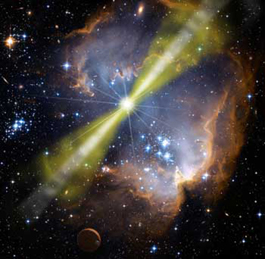Astrophysics Science Division
The Astrophysics Science Division supports the GSFC astrophysics projects by providing scientific leadership and
supports a research program to achieve NASA's strategic science goals. The key questions addressed by the Divisions research
programs include:
- How do galaxies, stars, and planetary systems form and evolve?
- What is the diversity of worlds beyond our solar system?
- Which planets might harbor life?
- What powered the big bang?
- What is Dark Energy?
- What happens to space, time and matter at the edge of a black hole?
- What are the cycles of matter & energy in the evolving universe?
+ Read more about the Astrophysics Science Division
+ Read more about our Laboratories
Links
| 
|
News Feature

Image Credit: NASA/Swift/Mary Pat Hrybyk-Keith and John Jones
"Naked-Eye" Gamma Ray Burst Was Aimed Squarely at Earth
Data from satellites and observatories around the globe show a jet from a powerful stellar explosion witnessed March 19 was aimed almost directly at
Earth. NASA's Swift satellite detected the explosion - formally named GRB 080319B - at 2:13 a.m. EDT that morning and pinpointed its position in the
constellation Bootes. The event, called a gamma-ray burst, became bright enough for human eyes to see. Observations of the event are giving
astronomers the most detailed portrait of a burst ever recorded.
+ Read more
+ Archive
|
| 
|
Current Missions
Missions in Development
James Webb Space Telescope (JWST)
JWST is an infrared-optimized space telescope designed
to study the earliest stars and galaxies.
+ Read More
NuSTAR
NuSTAR is a pathfinder mission that will open the high energy X-ray sky for sensitive study for the first time.
+ Read More
Astro-H
Astro-H (formerly known as "NeXT") is a facility-class mission to be launched on a JAXA H-IIA into low Earth orbit.
Stratospheric Observatory for Infrared Astronomy (SOFIA)
SOFIA is a 2.5-meter telescope for infrared to far-infrared astrophysics carried
aboard a Boeing 747-SP aircraft. GSFC is responsible for the SAFIRE
instrument.
+ Read More
Future Missions
Physics of the Cosmos Missions (formerly Beyond Einstein)
Beyond Einstein consists of several missions:
+ Read More
|
|

